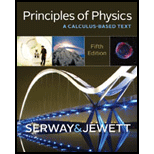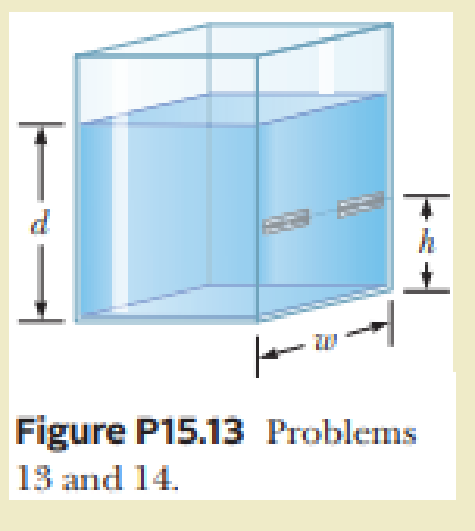
Concept explainers
Review. The tank in Figure P15.13 is filled with water of depth d. At the bottom of one sidewall is a rectangular hatch of height h and width w that is hinged at the top of the hatch. (a) Determine the magnitude of the force the water exerts on the hatch. (b) Find the magnitude of the torque exerted by die water about die hinges.

(a)
The magnitude of the force the water exerts on the hatch.
Answer to Problem 14P
The magnitude of the force the water exerts on the hatch is
Explanation of Solution
The air outside and the water inside the tank exert atmospheric pressure so that only excess water pressure counts for the total force.
The diagram is shown below.

Consider a strip of hatch at a distance
Write the equation for the pressure due to the water at depth
Here,
Write the equation for the pressure in terms of force.
Here,
Rewrite the above equation for
Use the above equation to write the expression for the force exerted on the considered strip.
Here,
Write the equation for
Here,
Put equations (I) and (III) in equation (II).
Write the equation for the total force.
Here,
Put equation (IV) in the above equation and integrate it.
Conclusion:
Simplify equation (V) to find
Therefore, the magnitude of the force the water exerts on the hatch is
(b)
The magnitude of the torque exerted by the water about the hinges.
Answer to Problem 14P
The magnitude of the torque exerted by the water about the hinges is
Explanation of Solution
Write the equation for the total torque.
Here,
The lever arm of the force
Refer to the diagram and write the equation for
Put the above equation in equation (VI).
Put equation (IV) in the above equation and rearrange it.
Find the value of the above integral.
Conclusion:
Simplify equation (VII) to find
Therefore, the magnitude of the torque exerted by the water about the hinges is
Want to see more full solutions like this?
Chapter 15 Solutions
Principles of Physics: A Calculus-Based Text
Additional Science Textbook Solutions
Genetics: From Genes to Genomes
Anatomy & Physiology (6th Edition)
Principles of Anatomy and Physiology
Fundamentals Of Thermodynamics
Essentials of Human Anatomy & Physiology (12th Edition)
- 1. Measurements and Linear Regression 1.1 Introduction The objective of this lab assignment is to represent measurement data in graphical form in order to illustrate experimental data and uncertainty visually. It is often convenient to represent experimental data graphically, not only for reporting results but also to compute or measure several physical parameters. For example, consider two physical quantities represented by x and y that are linearly related according to the algebraic relationship, y=mx+b, (1.1) where m is the slope of the line and b is the y-intercept. In order to assess the linearity between y and x, it is convenient to plot these quantities in a y versus x graph, as shown in Figure 1.1. Datapoints Line of regression Figure 1.1: Best fit line example. Once the data points are plotted, it is necessary to draw a "best fit line" or "regression line" that describes the data. A best fit line is a straight line that is the best approximation of the given set of data, and…arrow_forwardPlease help with Statistical Analysis table. These are trials from a Newton's Laws of Motion lab, please help with standard deviation and margin of error. Thanks!arrow_forwardplease solve and answer the question correctly. thank you!!arrow_forward
- please solve and answer the question correctly. thank you!! (hint in 2nd photo)arrow_forwardNewton's Laws of Motion - Please help with the first angle calculations of standard deviation and margin of error. I just need a model and I can figure out the other two angles. Thanks!arrow_forward2. A battleship simultaneously fires two shells at enemy ships. If the shells follow the parabolic trajectories shown, which ship gets hit first? a. A b. both at the same time C. B d. need more information battleship Barrow_forward
- A m₁ = 1.70-kg aluminum block and a m₂ = 8.00-kg copper block are connected by a light string over a frictionless pulley. The two blocks are allowed to move on a fixed steel block wedge (of angle 0 = 31.5°) as shown in the figure. (For aluminum on steel, μk k = 0.36.) Мк Aluminum m Copper = 0.47. For copper on steel, Steel m2 Ꮎ (a) the acceleration of the two blocks m/s² (b) the tension in the string Narrow_forwardWhile the 83.3 kg Dora Milaje is in equilibrium, the rope makes a 70.0˚ angle with the horizontal. Assuming the coefficient of friction between her shoes and the ship is 0.772 and her static friction is at its maximum value, what is the tension in the cable?arrow_forwardCan someone help me asnwer this thank youarrow_forward
 Principles of Physics: A Calculus-Based TextPhysicsISBN:9781133104261Author:Raymond A. Serway, John W. JewettPublisher:Cengage Learning
Principles of Physics: A Calculus-Based TextPhysicsISBN:9781133104261Author:Raymond A. Serway, John W. JewettPublisher:Cengage Learning Physics for Scientists and Engineers: Foundations...PhysicsISBN:9781133939146Author:Katz, Debora M.Publisher:Cengage Learning
Physics for Scientists and Engineers: Foundations...PhysicsISBN:9781133939146Author:Katz, Debora M.Publisher:Cengage Learning Physics for Scientists and Engineers, Technology ...PhysicsISBN:9781305116399Author:Raymond A. Serway, John W. JewettPublisher:Cengage Learning
Physics for Scientists and Engineers, Technology ...PhysicsISBN:9781305116399Author:Raymond A. Serway, John W. JewettPublisher:Cengage Learning University Physics Volume 1PhysicsISBN:9781938168277Author:William Moebs, Samuel J. Ling, Jeff SannyPublisher:OpenStax - Rice University
University Physics Volume 1PhysicsISBN:9781938168277Author:William Moebs, Samuel J. Ling, Jeff SannyPublisher:OpenStax - Rice University College PhysicsPhysicsISBN:9781938168000Author:Paul Peter Urone, Roger HinrichsPublisher:OpenStax College
College PhysicsPhysicsISBN:9781938168000Author:Paul Peter Urone, Roger HinrichsPublisher:OpenStax College Physics for Scientists and EngineersPhysicsISBN:9781337553278Author:Raymond A. Serway, John W. JewettPublisher:Cengage Learning
Physics for Scientists and EngineersPhysicsISBN:9781337553278Author:Raymond A. Serway, John W. JewettPublisher:Cengage Learning





